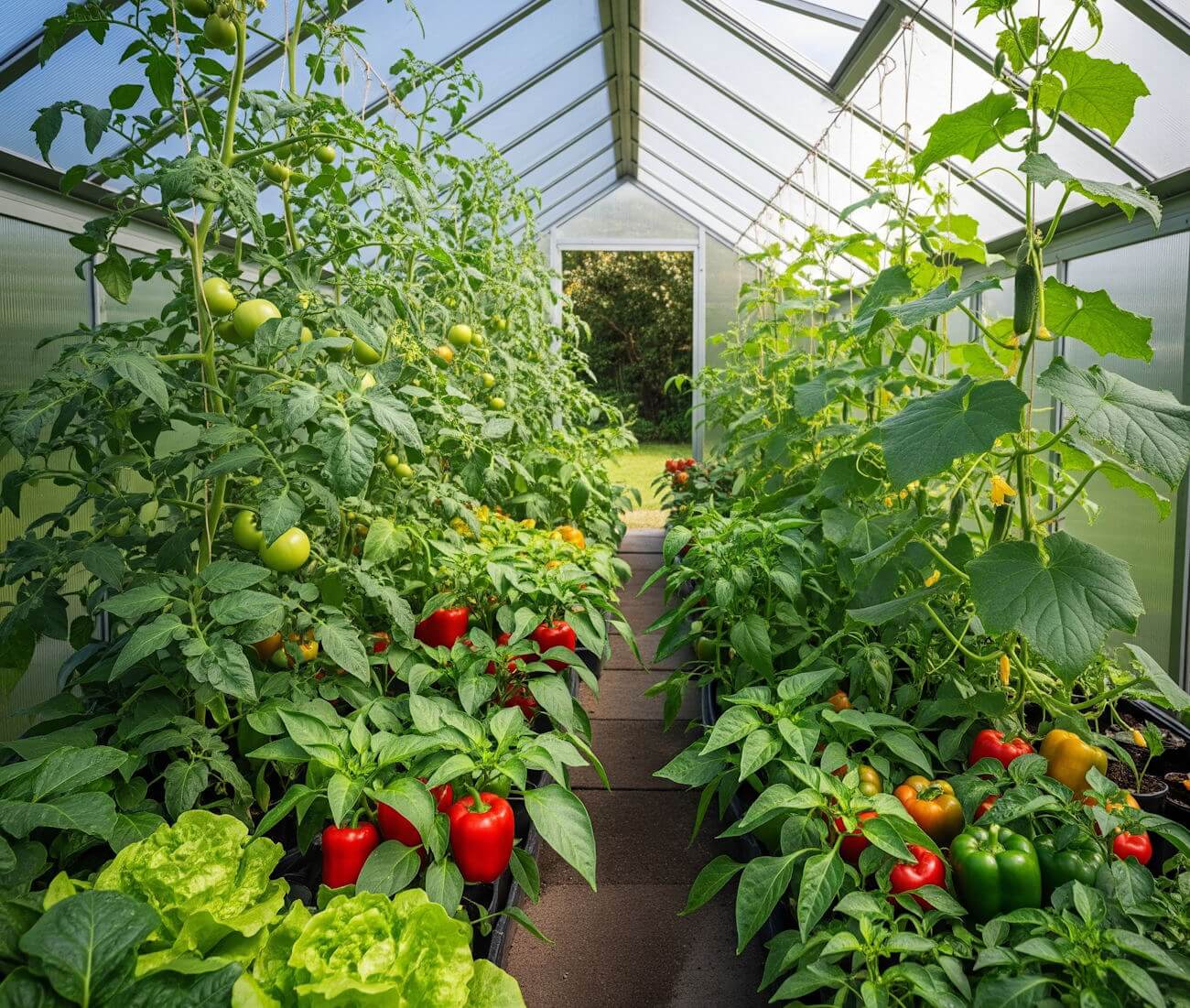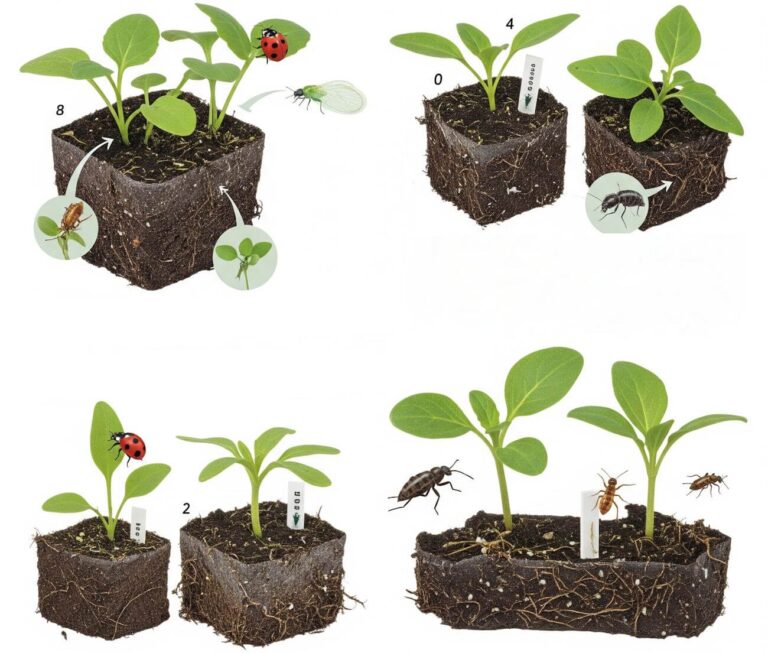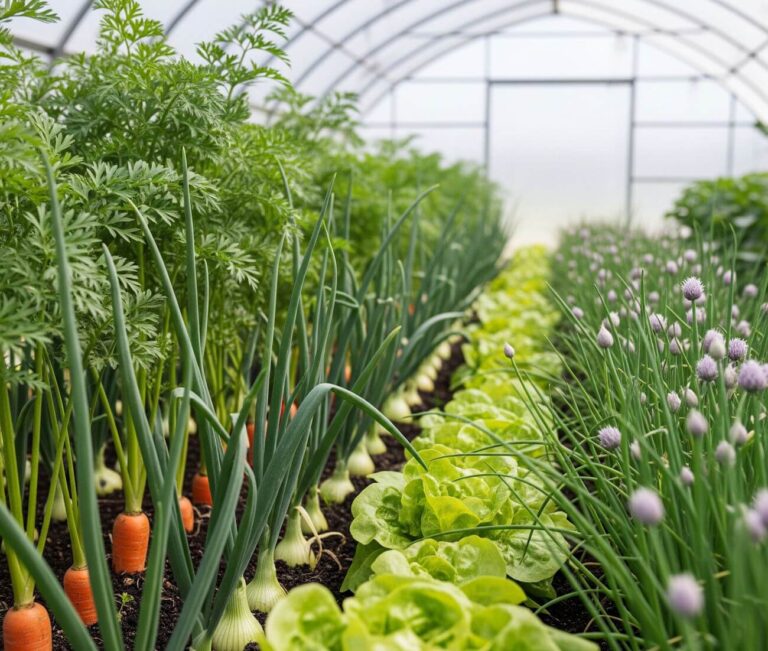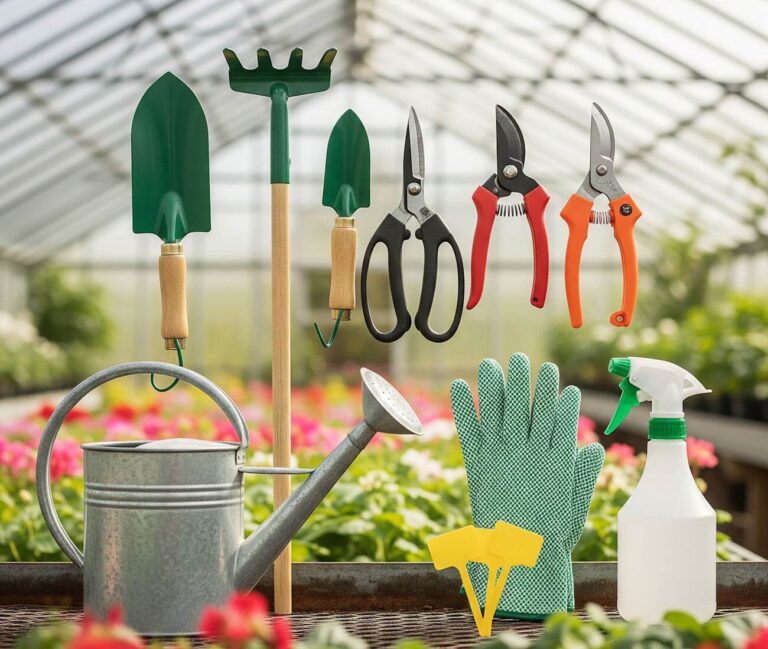Growing vegetables in a backyard greenhouse presents an excellent opportunity for both novice and seasoned gardeners to cultivate their favorite plants. A greenhouse allows for an extended growing season, enabling gardeners to start their vegetables from seed earlier in the spring and continue harvesting later into the fall. This extended time frame can be particularly beneficial in regions with shorter growing seasons, as it enables the production of crops that otherwise would not thrive due to climatic constraints.
One of the significant advantages of utilizing a greenhouse is the protection it offers against various environmental challenges. By creating a controlled atmosphere, gardeners can shield their plants from unpredictable weather conditions, such as frost and excessive rainfall. Additionally, the enclosed space reduces the risk of pest infestations and diseases that can devastate outdoor gardens. This enhanced protection allows for a healthier growing environment, which is crucial for nurturing seedlings.
When it comes to starting plants, growing vegetables from seed offers distinct benefits compared to purchasing seedlings. Seeds provide a wider variety of options, allowing gardeners to explore unique heirloom varieties or specific cultivars that might not be available as ready-made plants. Furthermore, starting from seed enables better control over the germination process and growth conditions, fostering a sense of accomplishment and a deeper connection to the plants. The act of nurturing seeds into thriving plants is both rewarding and educational, allowing gardeners to develop their skills and understand the nuances involved in growing vegetables.
In essence, utilizing a backyard greenhouse for starting vegetables from seed can transform an average gardening experience into a fruitful and enjoyable endeavor. With the right knowledge and dedication, gardeners can reap the benefits of enhanced growth conditions, increased variety, and healthier plants.
Choosing the Right Seeds for Your Greenhouse
Selecting the appropriate seeds is a fundamental step in maximizing the productivity of a greenhouse. Factors to consider include climate compatibility, growth habits, and space requirements. Different crops exhibit diverse growth patterns and requirements; for example, some vegetables thrive in cooler temperatures, while others prefer warmer conditions. Understanding the microclimate of your greenhouse enables you to choose seeds that will flourish in that environment. Make sure to consider the average temperature and humidity levels, as these will help determine which crops will thrive.
Another important aspect to contemplate is the growth habit of the plants. Bush varieties of vegetables, such as certain types of beans, are ideal for smaller spaces, while vining plants like cucumbers may require additional vertical space. Assessing your greenhouse’s available square footage and the potential for vertical gardening can influence your seed selections significantly. Additionally, consider the harvest time; some plants mature quickly, allowing for multiple crops within a single season, while others may require a longer grow period.
Seed viability is another critical consideration, as it impacts the success of your greenhouse gardening endeavors. Always select high-quality seeds to enhance germination rates and plant health. Look for seeds packaged from reputable distributors or those that have been tested for viability through established seed catalogs. Popular catalog options often provide valuable information regarding the seeds’ origins, growth habits, and expected yield, enabling gardeners to make informed decisions.
Ultimately, the right seeds will not only thrive in your greenhouse but also lead to a bountiful harvest. By evaluating climate compatibility, growth habits, space needs, and seed quality, you can cultivate a productive greenhouse that meets your gardening goals.
Top 5 Vegetables to Grow from Seed
When considering the best vegetables to grow from seed in a backyard greenhouse, certain varieties excel due to their growth requirements, flavor profiles, and cultivation ease. Here we highlight five vegetables that thrive in greenhouse environments: tomatoes, peppers, cucumbers, lettuce, and herbs.
Tomatoes are a favorite among home gardeners for their versatility and rich flavor. They thrive in warm climates and require full sunlight, making greenhouses an ideal setting. To achieve the best results, it is recommended to select determinate varieties that produce fruit simultaneously, or indeterminate types for a continual harvest. Furthermore, ensuring adequate air circulation and maintaining temperatures between 70°F and 85°F during the day will yield the most flavorful tomatoes.
Peppers, similar to tomatoes, enjoy warm conditions and require plenty of sunlight. Bell peppers, jalapeños, and other varieties can be grown successfully from seed in a greenhouse. They prefer slightly acidic soil and benefit from regular watering while avoiding waterlogged conditions. With the right environment, peppers can produce high yields and add a delightful spice to your meals.
Cucumbers are another excellent choice for greenhouse cultivation. These vegetables prefer consistent moisture and warm temperatures ranging from 70°F to 85°F. Trellising cucumbers can optimize space and increase air circulation, which helps prevent common diseases. With proper care, they offer a refreshingly crisp taste that enhances salads and snacks.
Lettuce is an exceptional vegetable for greenhouse growing due to its quick maturation time. Varieties such as romaine, butterhead, and loose-leaf do well in cooler temperatures ranging from 60°F to 70°F. Regular harvesting promotes continual growth, providing a steady supply of fresh greens for salads and sandwiches.
Finally, herbs such as basil, cilantro, and parsley can thrive in greenhouse conditions. They require moderate sunlight and can flourish in smaller pots, making them ideal for limited space. Cultivating herbs not only enhances culinary dishes but also introduces aromatic plants to your greenhouse garden.
Preparing Your Greenhouse for Planting
When venturing into the rewarding activity of growing vegetables from seed in a backyard greenhouse, the first step is to adequately prepare the environment. Proper preparation not only enhances the likelihood of successful germination but also promotes healthy plant growth throughout their lifecycle. One of the most crucial aspects of preparing your greenhouse involves soil preparation. Selecting the appropriate soil mix is essential; a balanced blend that retains moisture yet drains efficiently will provide the optimal growing conditions for seeds. A mix rich in organic matter, such as peat moss, coconut coir, and perlite, can help achieve this balance.
Incorporating compost into the soil mix presents numerous benefits, including enriching the nutrient content and improving soil structure. Compost enhances microbial activity in the soil, leading to healthier plants. As you prepare your soil, it is equally important to check the pH levels, which should ideally range between 6.0 and 7.0 for most vegetable seeds. Utilize a soil testing kit to ensure that your soil falls within this range, as an imbalance could hinder seed germination and plant development.
Once soil is prepared, focus on establishing the correct environmental conditions within your greenhouse. Essential elements include maintaining optimal temperatures that typically range between 65°F and 75°F (18°C to 24°C) for most seed varieties. Monitoring ventilation is vital to ensure adequate air circulation, which helps prevent mold growth and maintains humidity levels suited for seed germination. Generally, maintaining a relative humidity of around 50% to 70% is ideal. By thoughtfully addressing these considerations, you create a conducive environment that fosters successful seed growth and maximizes yield potential in your backyard greenhouse.
Sowing Seeds: Techniques and Best Practices
Sowing seeds in a backyard greenhouse can be an enriching experience, providing gardeners with the opportunity to grow a diverse array of vegetables. Understanding the best practices involved in this process is essential for maximum germination and healthy plant development. One of the first considerations is choosing between direct sowing and starting seedlings in trays. Direct sowing involves placing seeds directly into the greenhouse soil, which can be ideal for crops such as carrots and radishes that do not transplant well. In contrast, starting seedlings in trays allows for better control over growing conditions and can be particularly effective for larger plants like tomatoes and peppers.
Proper seed depth and spacing are critical factors that can significantly influence the success of your vegetable seeds. As a general rule, seeds should be planted at a depth that is roughly two to three times their diameter. This ensures that they have sufficient soil cover to maintain moisture while being able to break through once germination occurs. Additionally, spacing seeds according to their mature size is crucial; overcrowding can lead to competition for nutrients, sunlight, and water, subsequently affecting growth and yield.
Watering techniques also play a pivotal role in seed sowing. A consistent moisture level is necessary to aid germination, yet it is essential not to over-water as this may result in rot or fungus. A gentle spray or mist can provide the moisture needed without displacing the seeds. Utilizing a watering can or a fine-mist sprayer helps ensure that seeds are evenly hydrated. Maintaining humidity within the greenhouse can further encourage germination, but proper ventilation is also required to prevent mold growth and other diseases.
Incorporating these techniques into your gardening routine will enhance your efficiency as a grower. Following best practices ensures that your backyard greenhouse will yield a thriving vegetable garden, ready to provide fresh produce at harvest time.
Caring for Your Seedlings
Once your seeds have germinated in the controlled environment of a backyard greenhouse, providing appropriate care for your seedlings is vital for their successful growth. Proper attention during this early stage can significantly influence their eventual health and yield.
Watering schedules play an essential role in maintaining healthy seedlings. It is crucial to keep the soil consistently moist but not waterlogged. Typically, seedlings require watering every few days, depending on factors such as temperature, humidity, and pot size. Using a spray bottle or a gentle watering can help avoid disturbing the roots while ensuring adequate moisture.
Light requirements are another important aspect of seedling care. Seedlings generally thrive with 12 to 16 hours of light each day. Natural sunlight can be beneficial, but using grow lights can provide a consistent light source, particularly during shorter days. Ensure the lights are positioned at an appropriate distance to prevent burning the delicate leaves while promoting healthy growth.
Fertilization methods vary depending on the type of seedlings, but most benefit from a diluted, balanced fertilizer approximately two weeks after germination. Utilizing organic fertilizers can be advantageous for those focused on sustainable gardening practices. This will provide nutrients essential for robust growth without risking chemical buildup.
Pest management is also a crucial aspect of caring for seedlings. Regularly inspect your plants for signs of pests or diseases. If issues arise, consider using organic insecticidal soaps or neem oil as a preventive measure. Maintaining proper air circulation and cleanliness within the greenhouse is beneficial in minimizing pest infestations.
When it comes to transplanting seedlings, it is essential to do so when they have developed two to three true leaves and are sturdy enough to handle. Gradual acclimatization to outdoor conditions is important; therefore, hardening off the seedlings—exposing them to outside conditions gradually—will prepare them for transplanting into the garden.
Common Challenges in Greenhouse Vegetable Gardening
Growing vegetables from seed in a backyard greenhouse can be a rewarding experience; however, it is not without its challenges. One of the most prevalent issues gardeners face is fungal diseases, which often thrive in the warm, humid environment of a greenhouse. Common fungal infections such as powdery mildew or root rot can severely impact plant health. To mitigate these risks, it is advisable to ensure proper air circulation within the greenhouse, as well as regular cleaning and sterilization of tools. Additionally, employing organic fungicides and selecting disease-resistant seed varieties can be beneficial.
Pest infestations represent another significant challenge in greenhouse vegetable gardening. Common pests like aphids, spider mites, and whiteflies can quickly decimate young plants. Implementing integrated pest management (IPM) strategies is essential for maintaining a healthy garden. This may include introducing beneficial insects, such as ladybugs, as well as utilizing insecticidal soaps to reduce pest populations. Regular inspections and promptly addressing infestations will help protect vegetables throughout their growth cycle.
Watering practices are crucial in a greenhouse setting, where the balance between over and under-watering can be easily disrupted. Over-watering can lead to root rot and other complications, while under-watering can cause dehydration and stunted growth. To address this, gardeners should invest in moisture meters or soil sensors to monitor levels accurately and adjust their watering schedule accordingly. Sticking to a thorough but flexible watering regimen ensures that plants receive consistent moisture without the risk of waterlogging.
Lastly, temperature fluctuations can also pose a challenge in a backyard greenhouse. Sudden changes in temperature can stress plants, impacting their growth and yield. Utilizing thermostats and heaters, as well as shading techniques during hot weather, can help maintain a stable environment. Additionally, insulating the greenhouse during colder months promotes a more consistent temperature, ultimately benefiting the seeds and enhancing their successful growth.
Benefits of Crop Rotation and Companion Planting
Implementing crop rotation and companion planting in a backyard greenhouse can dramatically improve the health and productivity of your plants. Crop rotation involves alternating the types of crops grown in a particular area over different growing seasons. This practice helps to prevent soil depletion, as different plants utilize varying nutrients from the soil. For instance, legumes, such as beans and peas, are known to fix nitrogen in the soil, thus benefiting subsequent crops that require high nitrogen levels.
In addition to enhancing soil health, crop rotation can also reduce the incidence of pests and diseases. Many pests are crop-specific, meaning that if the same family of plants is grown year after year, these pests can thrive and lead to larger infestations. By rotating crops and introducing diverse horticultural families, you disrupt the life cycles of these pests. This practice not only limits pest populations but also minimizes the need for chemical interventions, making your greenhouse a safer and more sustainable environment.
Companion planting, on the other hand, involves growing certain plants in proximity to one another for mutual benefits. This method helps to enhance pest control, pollination, and nutrient uptake. For example, planting marigolds alongside vegetables like tomatoes can deter nematodes and aphids. Similarly, the classic trio of corn, beans, and squash—often referred to as the “Three Sisters”—illustrates the benefits of companion planting. While corn provides a structure for beans to climb, the beans contribute nitrogen to the soil, and squash shades the ground, helping to suppress weeds.
To implement these practices effectively, consider planning your greenhouse layout and crop schedule ahead of time. Maintain a detailed record of what is planted where, and be mindful of the seasonal preferences of your chosen plants. By fostering a harmonious greenhouse ecosystem through crop rotation and companion planting, you can enhance both plant health and overall yields.
Conclusion: Enjoying the Fruits of Your Labor
Growing vegetables from seed in a backyard greenhouse offers a rewarding experience that extends far beyond the mere act of gardening. As you embark on this horticultural journey, you cultivate not just plants, but also a profound connection with nature. Watching seeds transform into robust vegetable plants is a testament to the nurturing process that defines gardening. It is a fulfilling activity that allows individuals to engage with the cycle of life, further enhancing one’s appreciation for the food produced.
The flavors and freshness of homegrown vegetables are unmatched. Unlike store-bought varieties, your greenhouse produce benefits from being harvested at its peak ripeness, ensuring maximum flavor and nutritional value. Imagine biting into a juicy tomato or crisp cucumber, knowing you have nurtured them from seed to harvest. This experience promotes a sustainable lifestyle, as homegrown gardening reduces dependence on commercial agriculture and its associated environmental impacts.
Encouraging experimentation is essential for enhancing your gardening skills. Each season presents an opportunity to trial different vegetable varieties, expanding your palate and enhancing your gardening repertoire. Whether you choose to grow heirloom varieties or opt for more common vegetables like peppers and lettuce, each plant pleases in its journey from seed to harvest. Sharing your successes and challenges within the gardening community cultivates a network of enthusiasm and support, inspiring others to embark on their own greenhouse adventures.
Ultimately, the joy of growing vegetables from seed in a greenhouse lies in the satisfaction of nurturing and harvesting your produce. As you cultivate your skills and share experiences, you contribute to a growing community that values the art of gardening. The journey may require patience and dedication, but the delicious results make every moment worthwhile.







